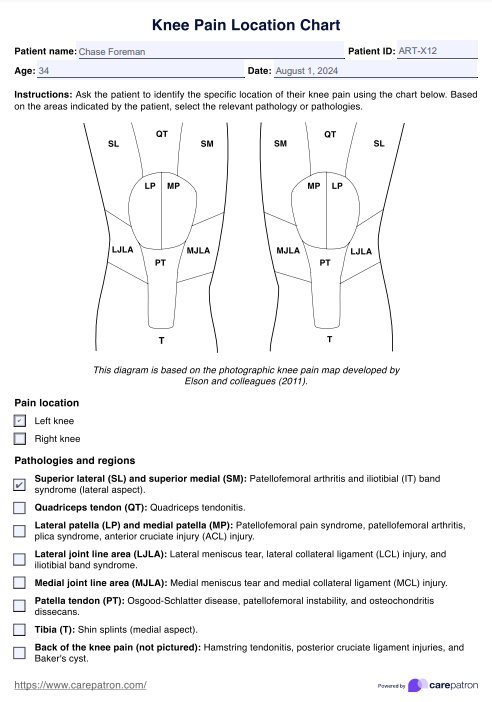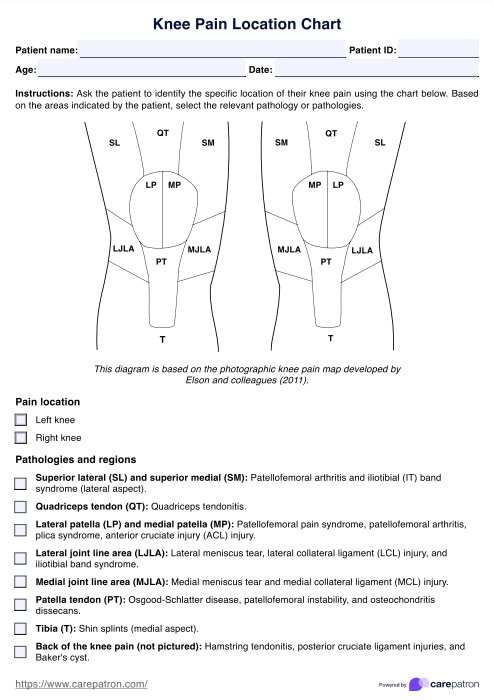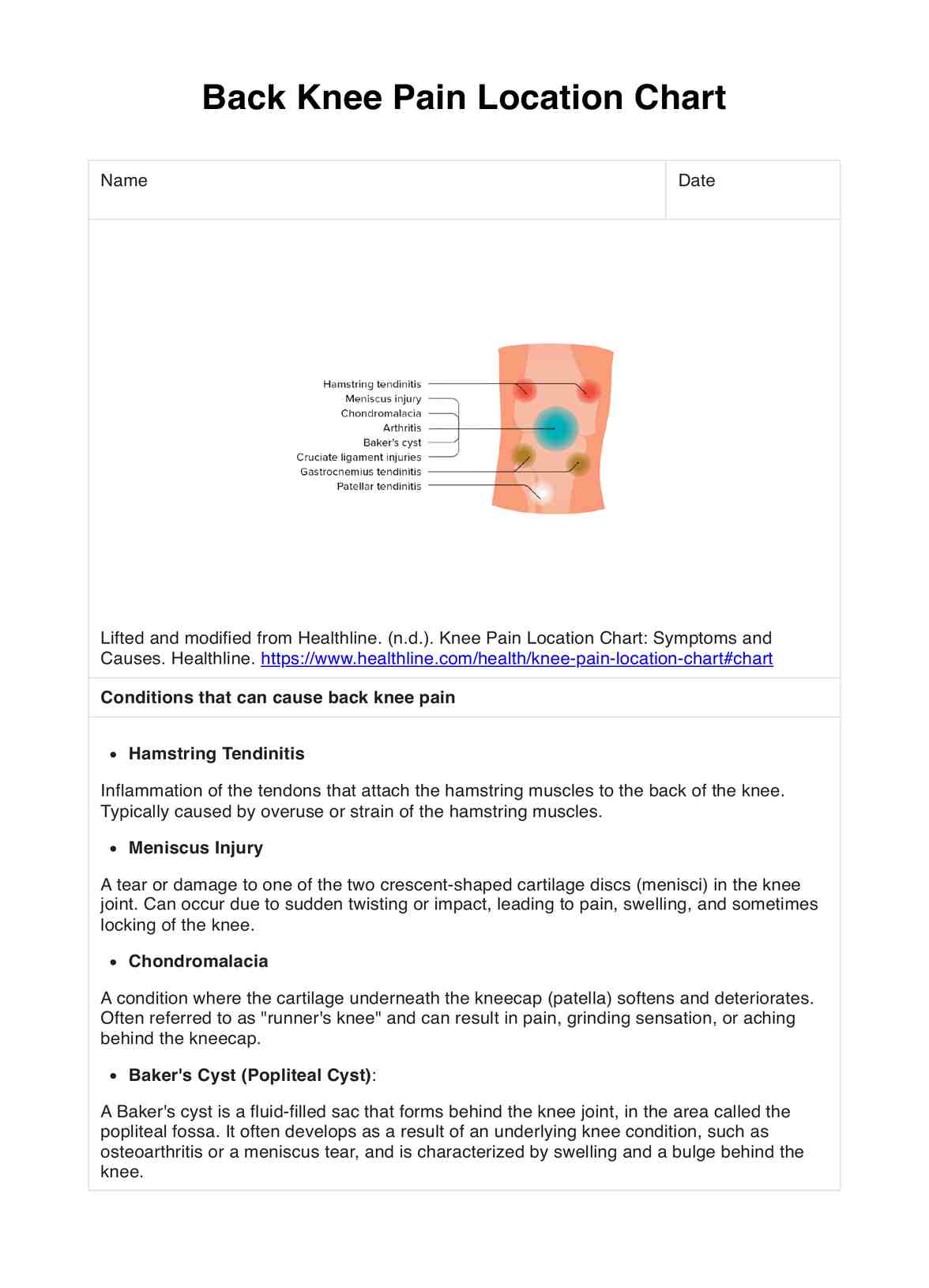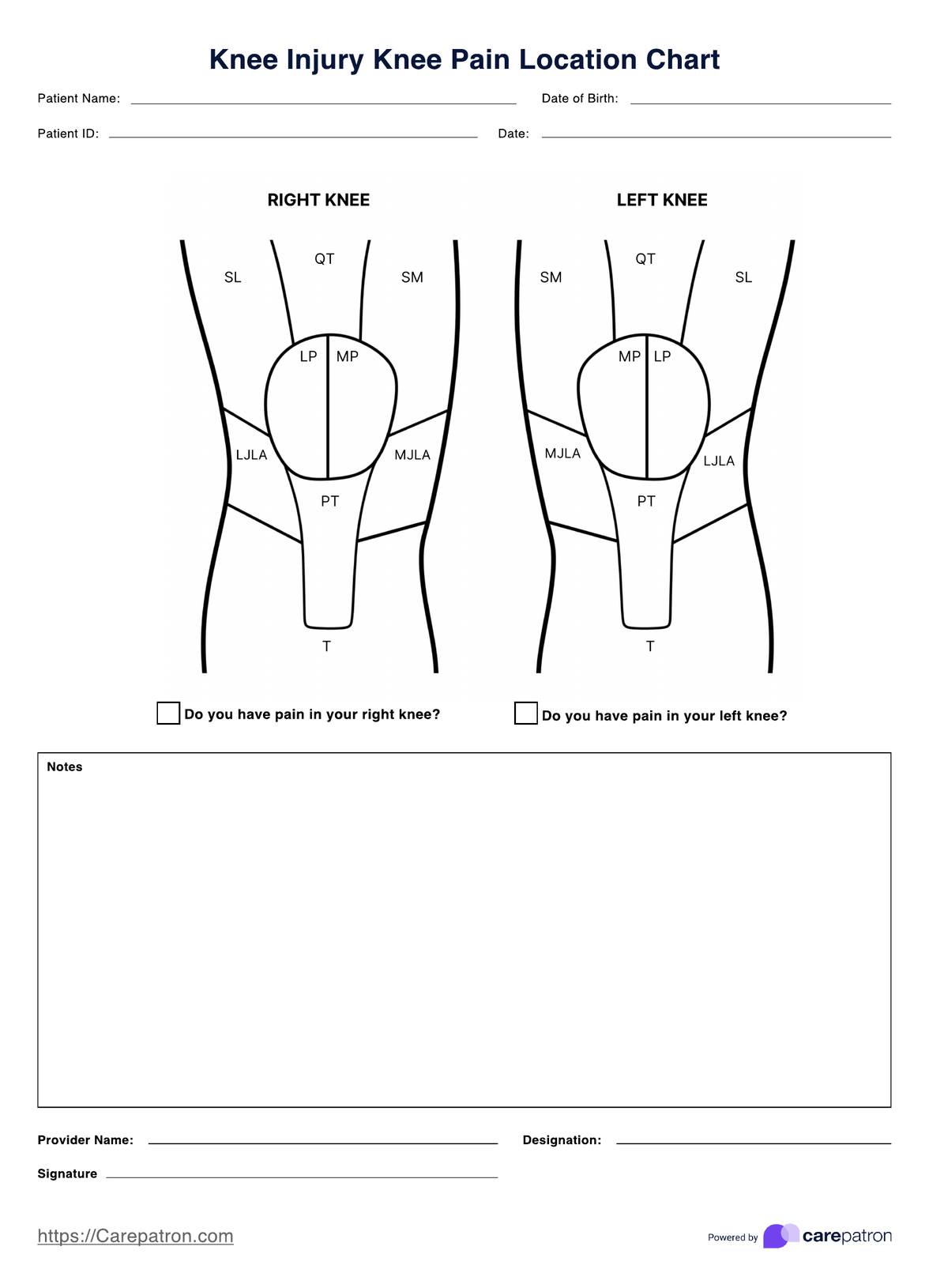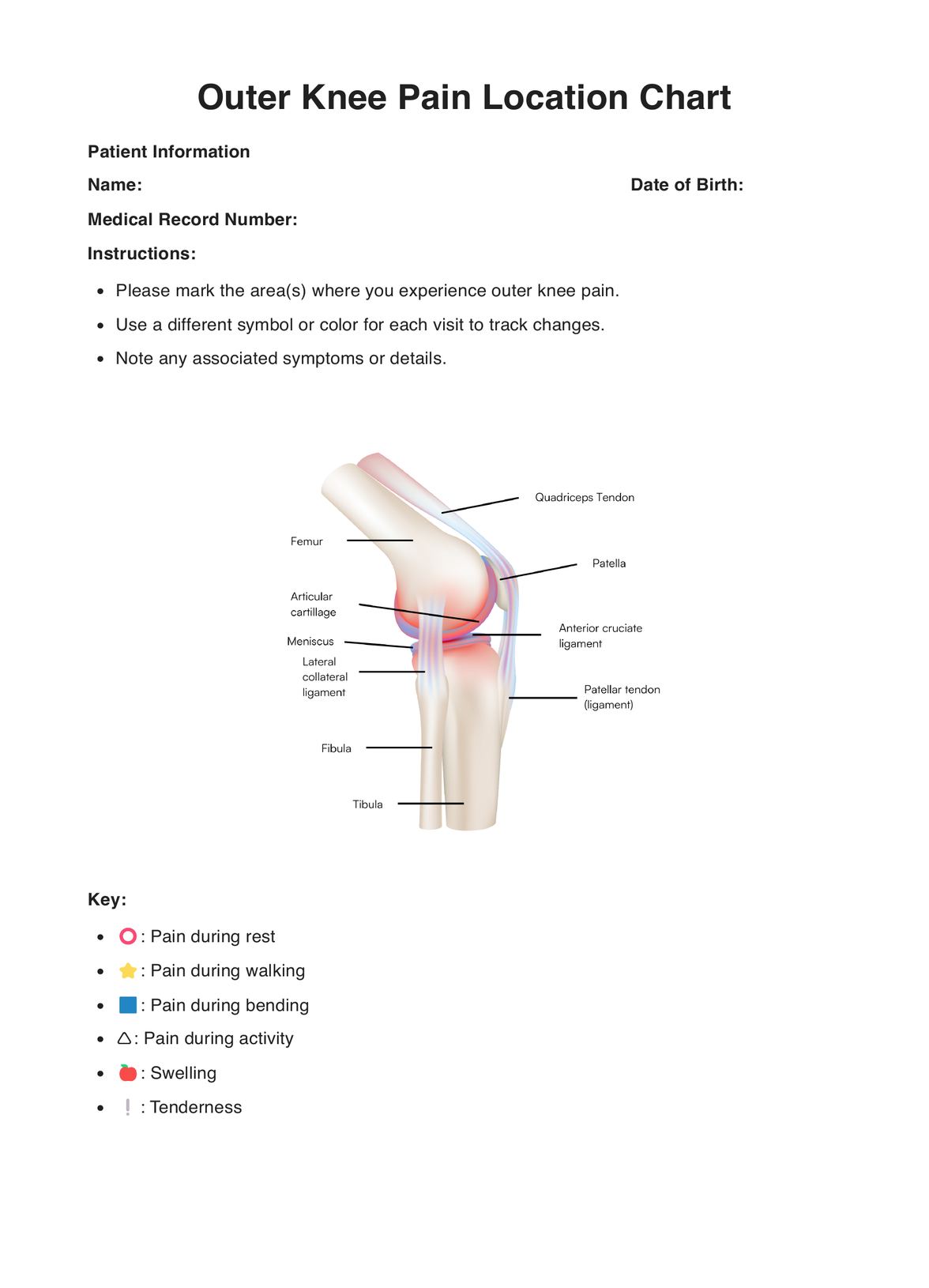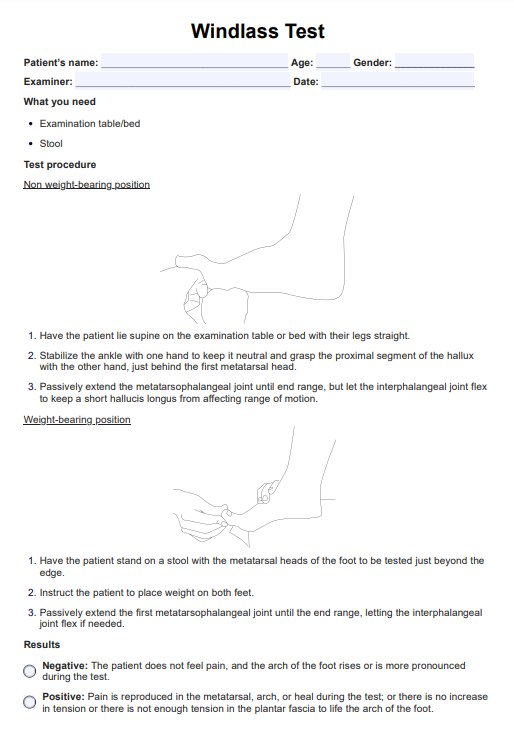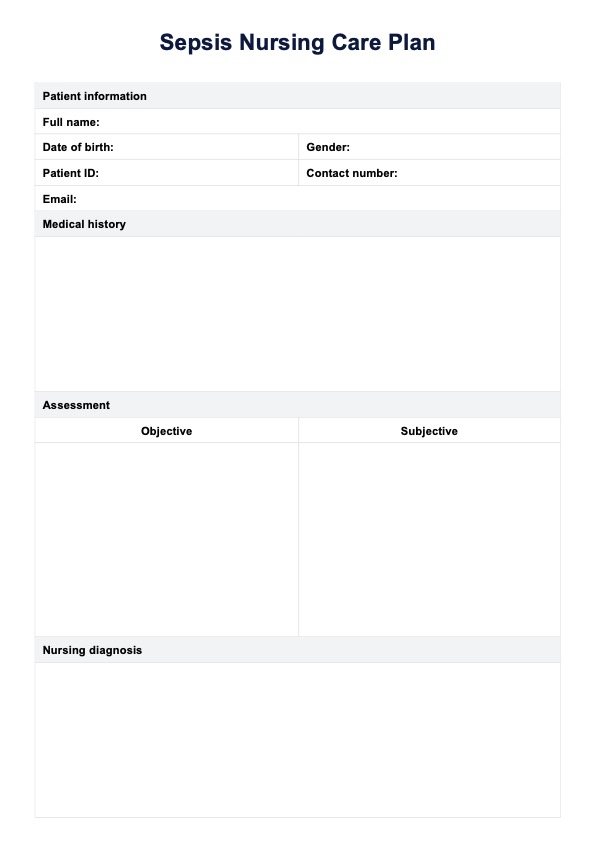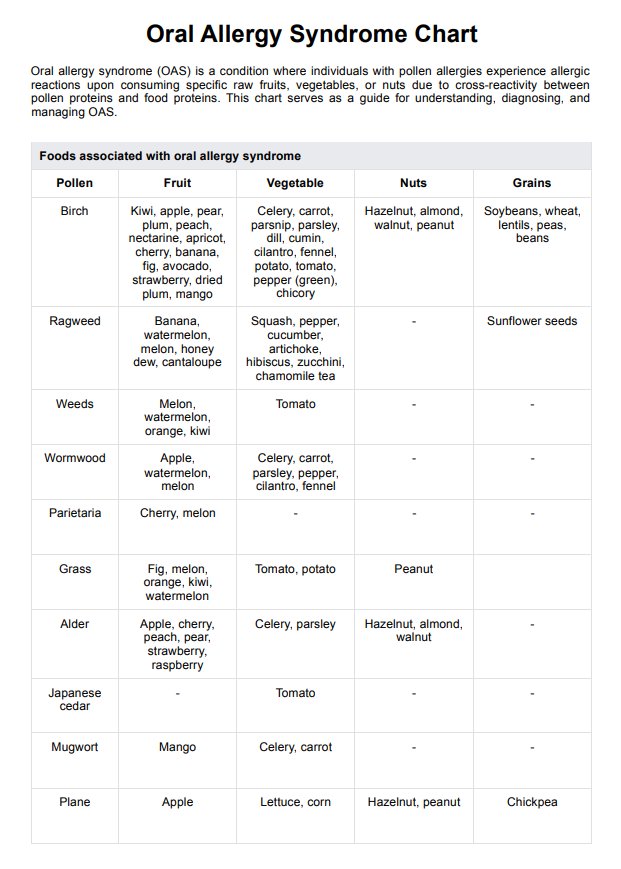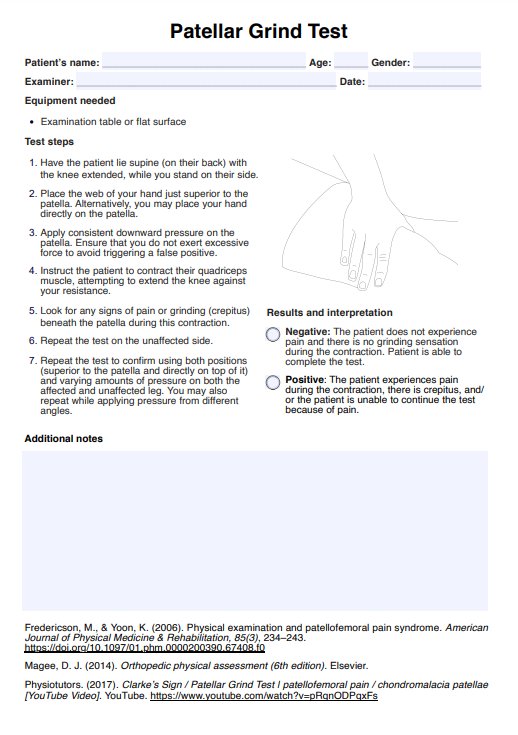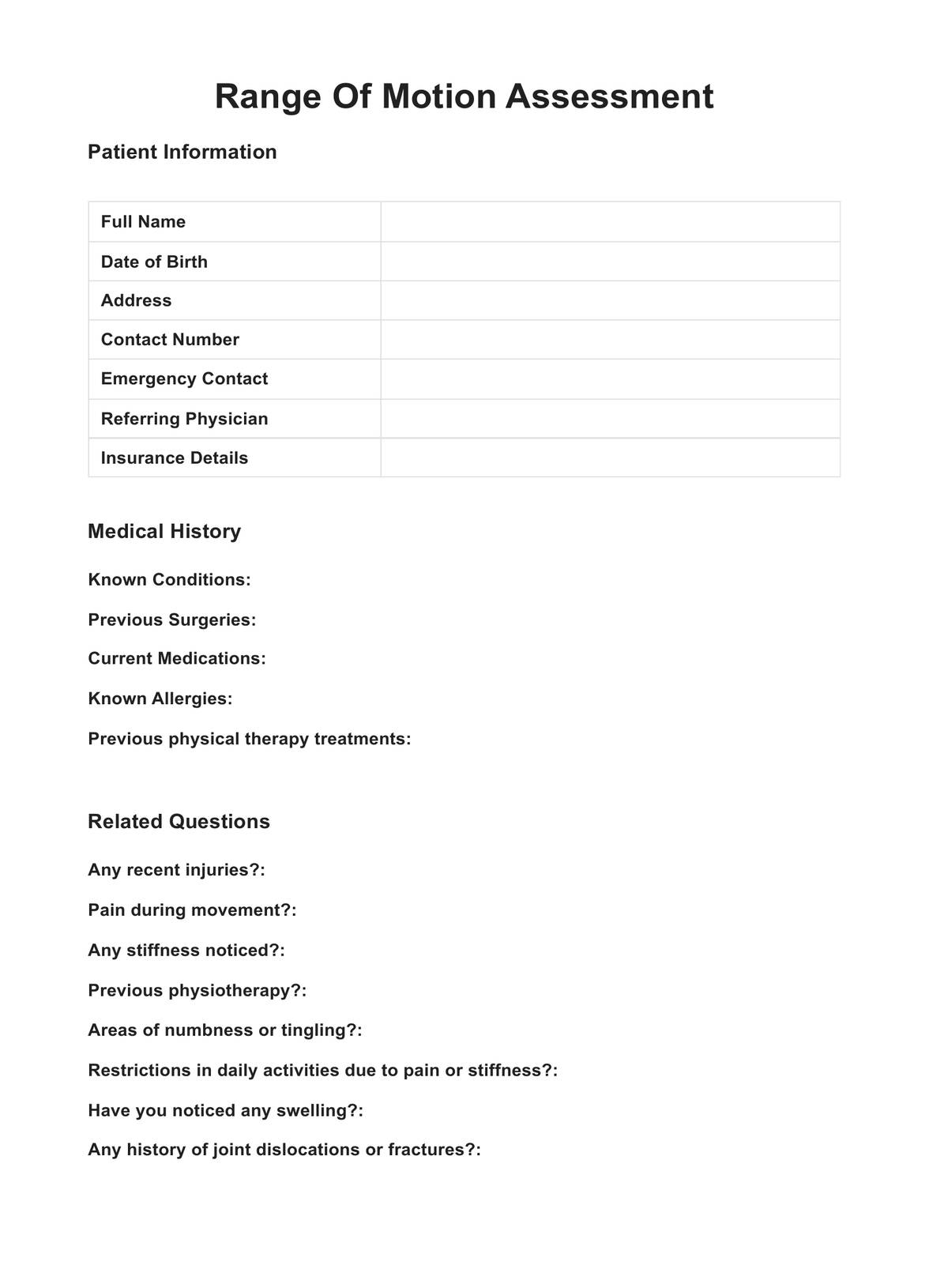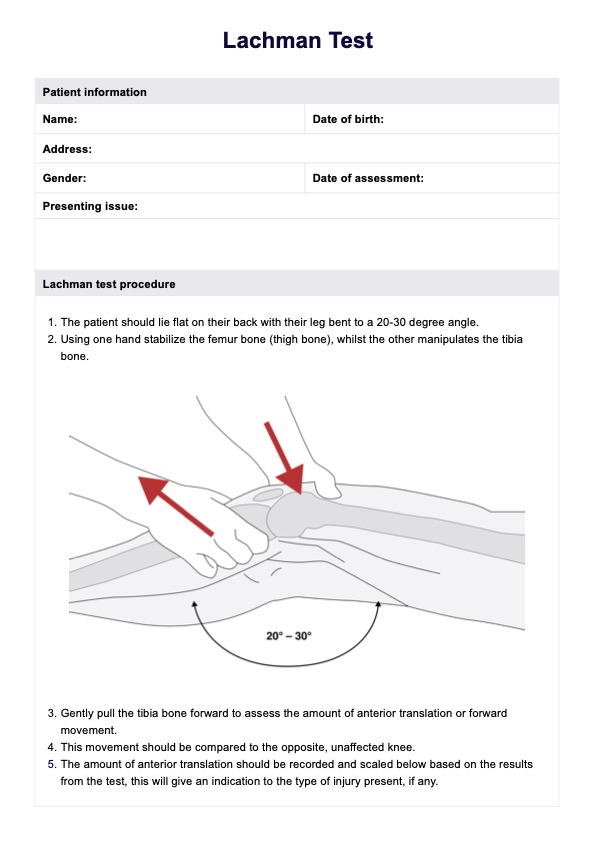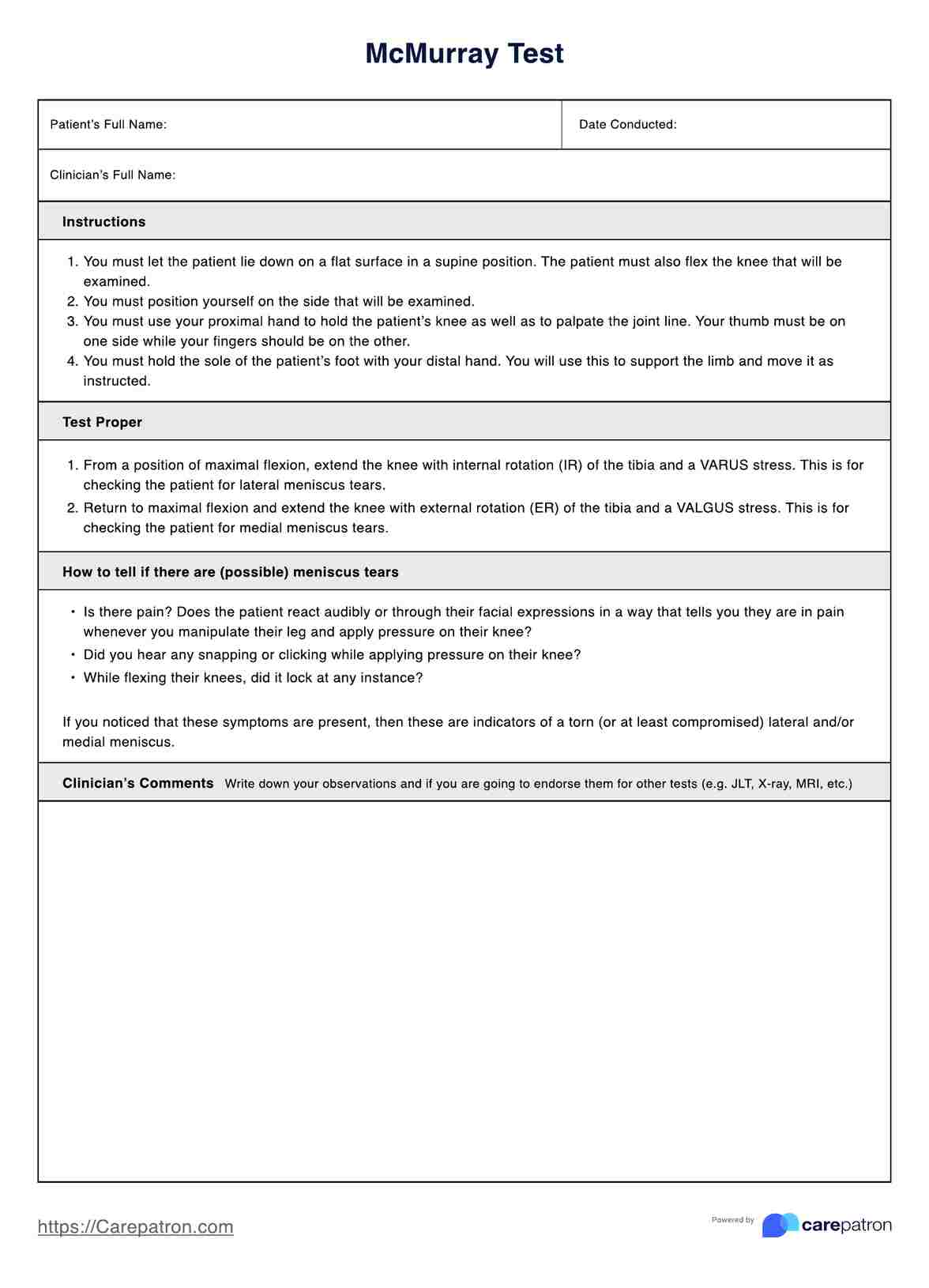Knee Pain Location Chart
Use our Knee Pain Location Chart to identify the cause of your patient's discomfort. Download our free PDF now.


What causes knee pain?
Knee pain can arise from various causes, ranging from acute injuries to chronic conditions. Understanding the potential underlying factors is crucial for accurate diagnosis and effective treatment.
Here are some common causes of knee pain:
- Arthritis: Osteoarthritis, rheumatoid arthritis, and other forms of arthritis can cause inflammation, joint degeneration, and pain in the knee joint.
- Overuse injuries: Repetitive stress or overuse during activities like running, jumping, or sports can lead to conditions in the knee bones such as patellofemoral pain syndrome, tendinitis (e.g., patellar tendinitis, quadriceps tendinitis), or bursitis.
- Traumatic injuries: A traumatic injury like ligament tears, meniscus tears, or fractures can result in significant knee pain and instability.
- Biomechanical issues: Abnormalities in the alignment or function of the knee joint, such as patellofemoral malalignment or gait abnormalities, can contribute to knee pain over time.
- Muscle imbalances: Weaknesses or imbalances in the muscles surrounding the knee, such as the quadriceps, hamstring, or calf muscles, can increase strain on the joint and lead to pain.
- Obesity: Excess weight places additional stress on the knee joint, increasing the risk of developing osteoarthritis and other knee problems.
- Age-related degeneration: As individuals age, the cartilage and other structures within the knee joint can naturally degenerate, leading to pain and decreased mobility.
It's important to note that knee discomfort and knee pain can also be a symptom of underlying medical conditions, such as rheumatoid arthritis, gout, or certain types of cancer. Therefore, a thorough evaluation is essential to determine the exact cause and develop an appropriate treatment plan.
Knee Pain Location Chart Template
Knee Pain Location Chart Example
What is a Knee Pain Location Chart?
When dealing with knee pain, it's crucial to understand the specific location of the discomfort. This can provide valuable insights into the underlying cause and guide appropriate treatment. A Knee Pain Location Chart can help healthcare practitioners precisely identify the area of concern and communicate effectively with their patients.
One standard method of visualizing knee pain locations is using a knee diagram divided into sections. This diagram typically features anterior (front), posterior (back), medial (inner), and lateral (outer) views of the knee joint.
Using a Knee Pain Location Chart can streamline the diagnosis process, allowing for swift identification of injuries such as lateral collateral ligament injuries or a posterior cruciate ligament injury, facilitating prompt and appropriate management strategies tailored to the patient's condition.
How does this Knee Pain Location Chart work?
This knee pain diagnosis chart features the diagram of the left and right knees based on the photographic knee pain map developed by Elson and colleagues (2011).
Step 1: Download the template
Get a copy of the Knee Plain Location Chart via the link on this page or through the Carepatron app. Use the print or digital format for your convenience.
Step 2: Identify the location of the knee pain
This diagram includes a simplified visual representation of the left and right knees and small labels for the different knee regions. Each region was identified as clinically relevant to certain common knee pathologies:
- Superior lateral (SL) and superior medial (SM): Patellofemoral arthritis and iliotibial (IT) band syndrome (lateral aspect).
- Quadriceps tendon (QT): Quadriceps tendonitis.
- Lateral patella (LP) and medial patella (MP): Patellofemoral pain syndrome, patellofemoral arthritis, plica syndrome, anterior cruciate ligament injury or ACL injury.
- Lateral joint line area (LJLA): Lateral meniscus tear, lateral collateral ligament (LCL) injury, and iliotibial band syndrome.
- Medial joint line area (MJLA): Medial meniscus tear and medial collateral ligament injuries.
- Patella tendon (PT): Osgood-Schlatter disease, patellofemoral instability, and osteochondritis dissecans.
- Tibia (T): Shin splints (medial aspect).
- Back of the knee pain: Hamstring tendonitis, posterior cruciate ligament injuries, and Baker's cyst.
Ask your patient to point the location of their pain using the template's diagram. Use the "Patholigies and Regions" options to help identify the affected area.
Step 3: Add extra notes in the space provided
Use the "Notes" section to jot down any extra information your patient provides regarding their knee pain. Make sure to ask follow-up questions to gather more information that may help with diagnosis and treatment.
The last step is to store the chart securely as part of your patient's electronic health record. This can also be further used as a reference when monitoring progress throughout treatment.
Common types of knee pain
There are various types of knee pain that healthcare practitioners frequently encounter. Understanding the common types of knee pain can aid in accurate diagnosis and effective treatment planning. Here are some of the most prevalent types of knee pain classified into their common locations:
Inner knee pain
When patients report inner knee pain (medial knee pain), the focus often turns toward medial structures like the medial meniscus, the medial collateral ligament or pes anserine bursitis. The MCL can be stretched or torn during activities involving a quick change of direction.
Outer knee pain
Conversely, outer knee pain can signify a lateral collateral ligament injury, usually due to a forceful blow to the inner knee that pushes the knee outwards, stressing the LCL on the opposite side.
This could also be associated with iliotibial band syndrome, an inflammation of the thick fibrous iliotibial band that can cause pain outside the leg. The lateral meniscus tear can also occur due to sudden twisting or direct impact on the knee, and it can also develop gradually over time due to wear and tear.
Anterior knee pain
This is frequently associated with patellar tendonitis, often termed "runner's knee," due to its prevalence in sports requiring repetitive knee movements. It's a condition born from stress on the patellar tendon, which connects the kneecap (patella) to the shin bone (tibia). A dislocated patella can also cause pain in this area.
Posterior knee pain
This pain at the back of the knee could be a symptom of a posterior cruciate ligament injury, part of the knee's major ligaments. These injuries often result from a blow to the front of the knee while it's bent, like what might occur in a car accident or a football tackle.
When should you use a Knee Pain Location Chart PDF?
Utilizing a Knee Pain Location Chart is particularly beneficial in the following scenarios:
Initial patient evaluation
During the initial consultation, providing patients with a Knee Pain Location Chart allows them to identify the location of their knee pain accurately. This information is crucial for healthcare practitioners to narrow down potential causes and associated conditions.
Tracking pain progression
By asking patients to indicate their knee pain location on the chart during follow-up visits, practitioners can monitor the condition's progression and assess the effectiveness of any prescribed treatments or interventions.
Documenting patient records
Incorporating this pain chart into patient records provides a clear visual representation of the pain location, which can be invaluable for future reference or when collaborating with other healthcare professionals.
Facilitating communication
Knee Pain Location Charts can bridge communication gaps by providing a common visual reference for patients and practitioners. This can be especially helpful in cases where language barriers or differing medical terminologies may confuse.
Patient education
By using a knee pain chart, healthcare practitioners can effectively educate patients about the various structures and components of the knee joint, and the potential causes of pain associated with each area. Integrating this chart and other Carepatron resources like the pain location chart template and medical record template can bolster your practice and enhance client performance.
While a Knee Pain Location Chart is a valuable tool, it should be used in conjunction with a comprehensive physical examination, medical history, and appropriate diagnostic tests to ensure an accurate diagnosis and proper treatment plan.
Reference
Elson, D. W., Jones, S., Caplan, N., Stewart, S., St Clair Gibson, A., & Kader, D. F. (2011). The photographic knee pain map: locating pain with an instrument developed for diagnostic, communication, and research purposes. The Knee, 18(6), 417–423. https://doi.org/10.1016/j.knee.2010.08.012
Commonly asked questions
It links the location of knee pain to common conditions affecting that specific area, allowing for a more focused examination and a quicker route to the correct diagnosis.
Yes, it can be helpful for various types of knee pain, including acute injuries, chronic conditions, and overuse injuries.
No, they can also help monitor the effectiveness of treatments and guide rehabilitation exercises or therapy for knee injuries.
Yes, hamstring muscle injuries often result in intense pain that can extend to the knee, affecting the joint's stability and function.
Degenerative joint disease can lead to increased pain levels in the knee due to the breakdown of cartilage, resulting in friction between bones and causing inflammation and discomfort.


